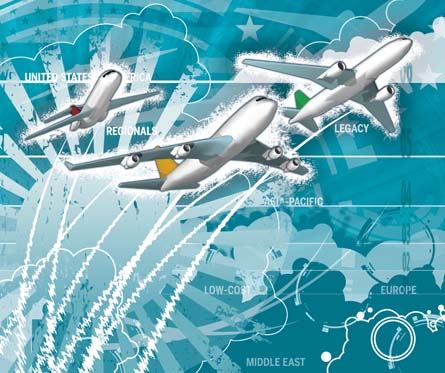With traffic growth starting to cool off and oil prices skyrocketing, the industry could be on the cusp of a downturn. But with aircraft orders continuing to pile in and growth markets such as China and India still sizzling, could there be an extended upswing?
Airbus and Boeing have good reason to be pleased with their week's work at the recent Farnborough Airshow. The European manufacturer, battered in the run up to the industry's annual shop window, finally gave in to popular airline opinion and decided to completely revisit its ideas in the mid-sized airliner market. It now has a revamped widebody proposal in the A350 Xtra Wide Body.
|
|---|
| Forecasters expect the industry to slow, the question is by how much and when? |
But perhaps even more significantly for Airbus, Singapore Airlines (SIA) weighed in as the show was about to close with a monster order for nine more A380s, 20 A350s and interim leases on 19 A330s. It is a powerful vote of confidence from one of its best customers, according to Airbus chief operating officer John Leahy. "[SIA] is saying that, despite all of this, I'm staying with the programme - I'm still mad at you - but I'm still on board."
The annual airshow sales battle, while largely irrelevant other than for grabbing headlines, demonstrated that airlines are still struck with order fever. Airbus booked orders for 182 aircraft worth $21.5 billion. The buzz at Boeing's chalet was no less fervent, with the US manufacturer announcing 75 orders worth $9.3 billion.
But as the hype surrounding an event like Farnborough dies down, and normal service resumes, the debate over where the industry truly lies in the economic cycle resumes. As this year's Airline Business World Airline Rankings show, 2005 was another record-breaking year in revenue and traffic terms. But growth is slowing from the super-charged levels of 2004. And forecasters expect it to slow more. The question is by how much and when?
Opinion is divided. Optimists argue that the industry is entering some kind of "super cycle", where new dynamics are at play that will ensure the good times endure. The pessimists, or realists, argue that it will only be a matter of time before high oil prices catch up and trip global economics into the next downturn. The manufacturers naturally fall into the former camp.
Boeing's new forecast has GDP growth at 3%, traffic growth at 5% and cargo growth at 6%. It believes the doomsayers predicting that the only way ahead for the industry is down may be missing a trick. "I think the sceptics are looking too much at past cycles - this one is different," says Randy Baseler, Boeing's vice-president of marketing. "The main reason is the big US and traditional European flag carriers have not participated in this cycle. Usually they are at the front of it." They are expected to begin ordering again later this year and into 2007.
Others point to low-cost carrier growth and the booming markets of China and India as reasons for cheer. And they are. However, there is evidence of markets or sectors that are growing because the structure of the market is changing. The issue is whether the traditional market cycle will be materially affected by these drivers, and if the new forces are strong enough to elongate the slowdown.
The pessimists believe it is questionable that even these superheated markets have the strength to make up a downturn or shortfall. They argue the market fundamentals have not changed. Volume, in terms of traveller numbers may be there, but profitability, and hence the ability to finance new aircraft and further expansion, is still elusive for many.
It is worth looking at what those savvy aircraft investors, the lessors, think. Figures from ACAS show that the major lessors are concentrating their narrowbody deliveries in the next three years, with 75% of their backlog entering service by the end of 2008. Their exposure after this is more limited when they believe demand will be less.
There is, for the time being, no compelling evidence either way on this cycle. The only sure thing is the industry is slowing. A faster downturn, one that would match previous cycles, means the industry will hit the bottom in 2008/9. The stretched cycle would see the industry holding out for a couple of years before it reached the same place. The safer bet in this troubled industry would surely be the more cautious outlook. ■
Journalism award Congratulations to our special correspondent Günter Endres whose article "Northern raiders" won the ARINC Award for Best Business or Financial Submission at the annual Aerospace Journalist of the Year Awards in mid-July. To read his article, click here. |
|---|
Source: Airline Business
























